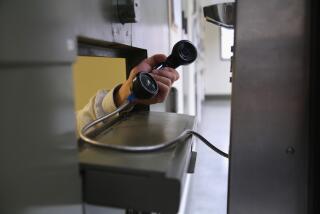Obama aims to overhaul immigration jail system
Pledging more oversight and accountability, the Obama administration announced plans Thursday to transform the nation’s immigration detention system from one reliant on a scattered network of local jails and private prisons to a centralized one designed specifically for civil detainees.
The reforms are aimed at establishing greater control over a system that houses about 33,000 detainees a day and that has been sharply criticized as having unsafe and inhumane conditions and as lacking the medical care that may have prevented many of the 90 deaths that have occurred since 2003.
“With these reforms, ICE will move away from our present, decentralized jail-oriented approach to a system that is wholly designed for and based on our civil detention needs,” U.S. Immigration and Customs Enforcement Assistant Secretary John Morton told reporters. “The population that we detain is different than the traditional population that is detained in a prison or a jail setting.”
The federal immigration agency plans to review the use of 350 local jails, state prisons and private facilities, including more than a dozen in California. Within five years, officials said, detainees without criminal records probably would be held in fewer, less-restrictive locations with more federal oversight.
Morton also announced that the agency would stop sending families to the controversial T. Don Hutto Family Residential Facility in Texas and instead hold them in the agency’s only other family facility, which is in Pennsylvania. The Texas facility, which will continue to house women, opened in 2006 and faced lawsuits over substandard living conditions. A settlement resulted in changes to how children were treated.
Immigrant rights advocates welcomed the changes but said there was still no clear policy on how detention facilities would be penalized if problems were found.
“We are encouraged that the administration is taking a hard look at what has traditionally been a dark spot in our immigration system,” said Karen Tumlin, a staff attorney at the Los Angeles-based National Immigration Law Center. “However, only time will tell if the reforms announced today amount to lasting change or simply creative repackaging of prior policies.”
Tumlin and others said the detention standards needed to be made legally binding to guarantee immigrants access to counseling, family visits, legal materials and recreation time. Legislation has been introduced aimed at accomplishing this.
Advocates also said that the government should use less punitive and less costly alternatives to detention, such as ankle bracelets or intensive supervision, for certain immigrants.
“We are very disappointed by the failure to discuss alternatives to detention in the proposal,” said Ahilan Arulanantham, an attorney at the American Civil Liberties Union of Southern California. “The system now detains thousands of people who are not a danger and not a flight risk.”
To increase oversight, the immigration agency would place federal monitors in 23 large facilities, which house more than 40% of the detainees. The agency also plans to hire experts in healthcare administration and detention management, and someone to review medical complaints.
“We need a system that is open, transparent and accountable,” Morton said.
A crackdown on illegal immigrants under the George W. Bush administration led to a dramatic increase in the detainee population, from 19,700 in fiscal year 2006 to 33,400 today. The budget for detention and deportation is nearly $2.5 billion, much of which is spent on contracts with private prison companies such as Corrections Corp. of America.
Morton said the agency did not plan to reduce the number of detainees or stop contracting with local governments and private corporations. But he said his staff would assess where detainees should be housed.
He said that many -- including some asylum seekers and those without criminal records waiting to be deported -- should be in facilities less restrictive than jails and prisons.
The announcement could result in significant changes in California, where more than 3,000 immigration violators are held in a private facility in San Diego, a government-run center in El Centro and 13 local jails throughout the state. Another federal facility on Terminal Island has been closed for repairs since 2007.
Morton’s predecessor at the immigration agency, Julie Myers, said the increased oversight started under the Bush administration. She said some of the new proposals, including reducing the number of local jail contracts, could pose concerns.
“Centralizing facilities makes sense in many respects,” she said. “However, there may be challenges in terms of attorney access and proximity to an immigrants’ family.”
UC Davis law professor Kevin Johnson, who has written about immigration laws and policies, applauded the changes but said creating a system that catered more to noncriminals may be “easier said than done.”
“It is nice to see that they are focusing on improving detention conditions rather than just increasing the number of people in detention,” he said. “But the devil is in the details.”
--
--
(BEGIN TEXT OF INFOBOX)
Key steps
Create an office to plan and design a civil detention system.
Establish an office of detention oversight to inspect centers and investigate grievances.
Hire experts in healthcare administration and detention management.
Hire a medical expert to provide an independent review of complaints.
Hire detention managers to oversee facilities housing more than 40% of detainees.
Create two advisory groups for local and national organizations to give input to the government.
Source: U.S. Immigration and Customs Enforcement
More to Read
Sign up for Essential California
The most important California stories and recommendations in your inbox every morning.
You may occasionally receive promotional content from the Los Angeles Times.










